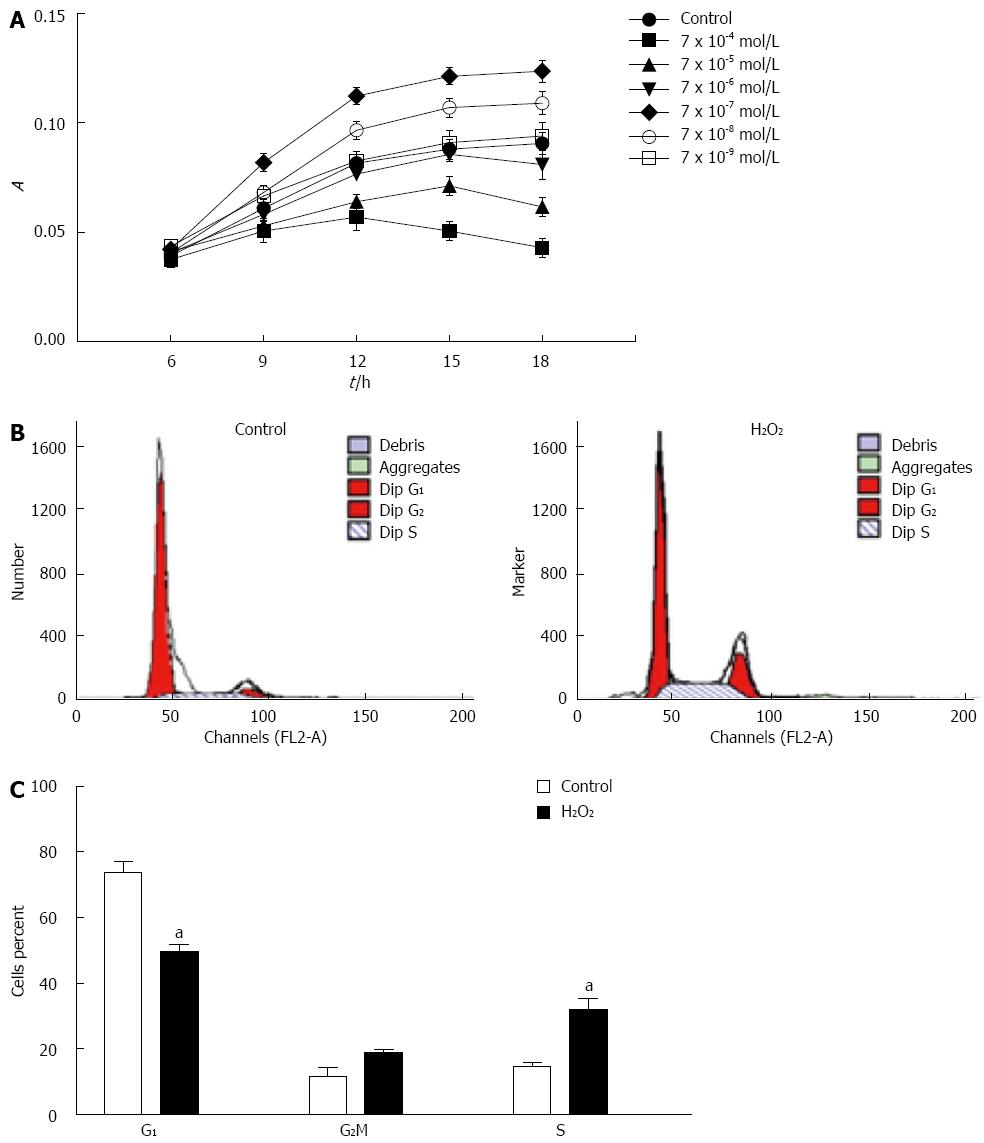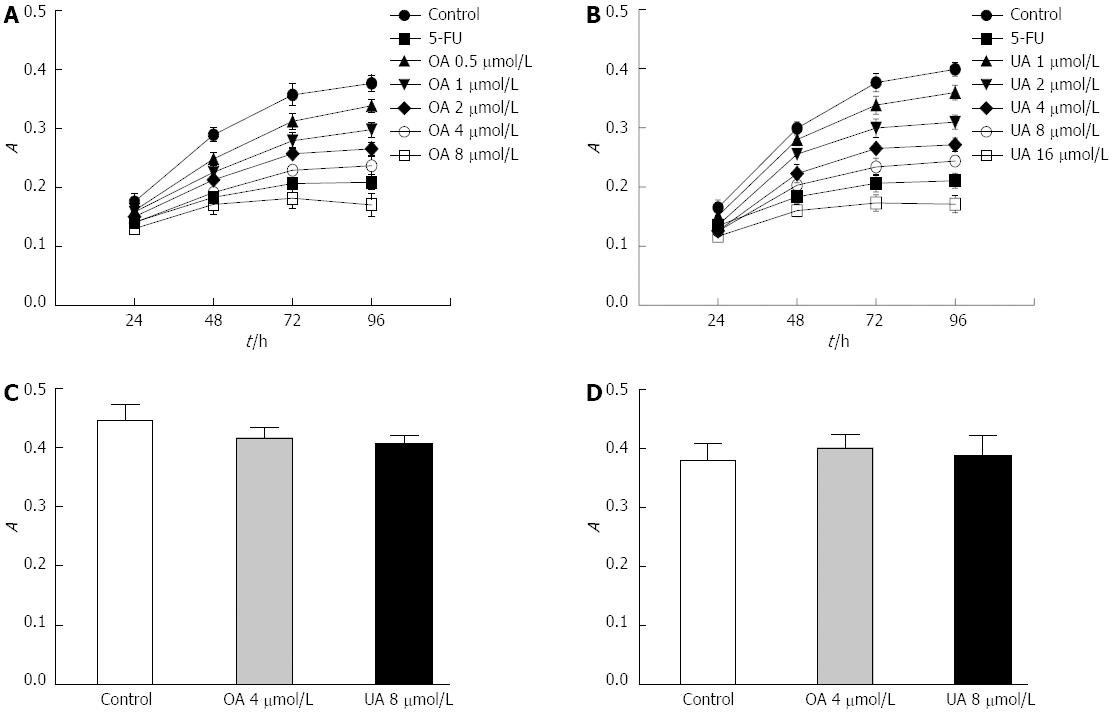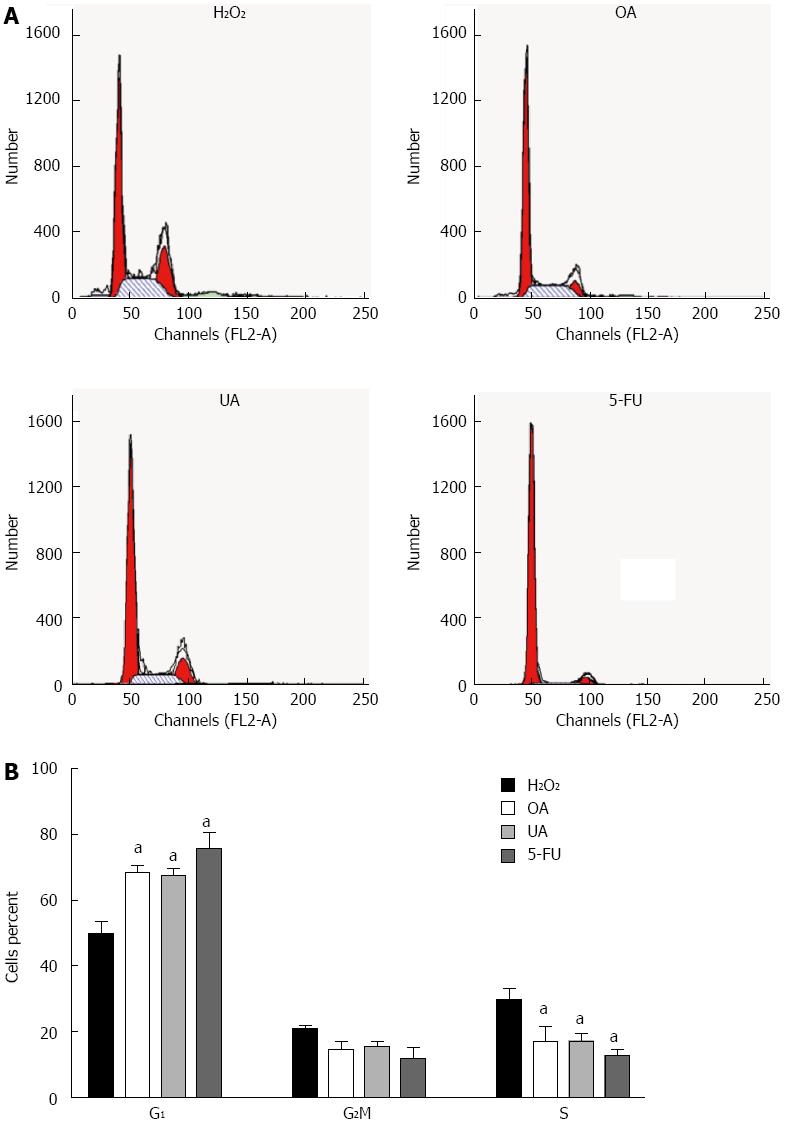Copyright
©2014 Baishideng Publishing Group Co.
World J Gastroenterol. Feb 7, 2014; 20(5): 1348-1356
Published online Feb 7, 2014. doi: 10.3748/wjg.v20.i5.1348
Published online Feb 7, 2014. doi: 10.3748/wjg.v20.i5.1348
Figure 1 H2O2 promoted WB-F344 cell proliferation.
A: The effect of H2O2 on cell proliferation. WB-F344 cells were exposed to 7 × 10-4-7 × 10-9 mol/L H2O2 for 6, 9, 12, 15, and 18 h. Cell proliferation was evaluated using the MTT assay. The data represent the mean ± SD derived from three independent experiments; B: Flow cytometric analyses of the cell cycle in H2O2-treated WB-F344 cells. The cells in the control and the H2O2 groups were stained with 10 μg/mL propidium iodide, and the DNA content was analyzed as described in the Materials and Methods; C: Histograms indicating the percentages of WB-F344 cells in the control and H2O2 exposure groups in the G1, G2/M and S phases. The data represent the mean ± SD derived from three independent experiments. aP < 0.05 vs control group.
Figure 2 H2O2 induced WB-F344 malignant transformation.
A: The morphology of H2O2-treated WB-F344 cells. The cells were cultured in complete medium (control) or treated with 7 × 10-7 mol/L H2O2 12 h per day for 21 d. Cell morphology was observed under microscope (× 400). An increasing nucleus to cytoplasm ratio was observed (green arrow), as were many mitotic cells (yellow arrow), prokaryotes (blue arrow) and even tumor giant cells (red arrow); B: The tumorigenicity of transformed WB-F344 cells as determined using the methylcellulose culture assay. Cell colony formation was observed under microscope (× 400); C: H2O2 increased WB-F344 cell aneuploidy. The cells were cultured in complete medium (control) or treated with 7 × 10-7 mol/L H2O2 12 h per day for 21 d and harvested for flow cytometry. DNA was stained with propidium iodide (10 μg/mL), and a BD FACS Calibur was used to analyze cellular DNA content. The population of > 4N cells represent aneuploidy cells. Histograms indicating the aneuploidy cells among the control cells and the H2O2-treated cells. The data represent the mean ± SD derived from three independent experiments.
Figure 3 Effect of oleanolic acid and ursolic acid on cell proliferation.
A, B: The inhibitory effect of oleanolic acid (OA) and ursolic acid (UA) on H2O2-induced cell proliferation. Cell proliferation was evaluated using the MTT assay (see Materials and Methods). The data represent the mean ± SD derived from three independent experiments; C: The effects of OA and UA on quiescent BRL rat liver epithelial cell proliferation. BRL cells were exposed to 4 μmol/L OA or 8 μmol/L UA for 72 h. Cell proliferation was evaluated using the MTT assay. The data represent the means ± SD derived from three independent experiments; D: The effects of OA and UA on quiescent WB-344 cells proliferation. WB-344 cells were exposed to 4 μmol/L OA or 8 μmol/L UA for 72 h. Cell proliferation was evaluated using the MTT assay. The data represent the mean ± SD derived from three independent experiments.
Figure 4 Growth inhibitory effects of oleanolic acid and ursolic acid on H2O2-treated WB-F344 cells.
A: Flow cytometric analyses of the cell cycle of H2O2-treated WB-F344 cells following treatment with oleanolic acid (OA) (4 μmol/L), ursolic acid (UA) (8 μmol/L) or 5-FU (0.05 mmol/L, positive control). After 72 h, the cells were harvested and stained with 10 μg/mL propidium iodide (PI), and the DNA content was analyzed, as described in the Materials and Methods; B: Cell cycle quantitative analysis. Histograms indicating the fraction of H2O2-treated WB-F344 cells and those that were treated with OA, UA or 5-FU in the G1, G2/M and S phases. The data represent the means ± SD derived from three independent experiments. aP < 0.05 vs H2O2 model group.
- Citation: Han YY, Xue XW, Shi ZM, Wang PY, Wu XR, Wang XJ. Oleanolic acid and ursolic acid inhibit proliferation in transformed rat hepatic oval cells. World J Gastroenterol 2014; 20(5): 1348-1356
- URL: https://www.wjgnet.com/1007-9327/full/v20/i5/1348.htm
- DOI: https://dx.doi.org/10.3748/wjg.v20.i5.1348












